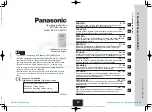
Instructions for use Fiamm Motive Power Water Less
®
/ Water Less
®
20
ENGLISH
Rating Data
1. Nominal capacity C
5
:
See type plate
2. Nominal voltage:
2.0 V x No of cells
3. Discharge current
C
5
/5h
4. Nominal S.G. of electrolyte*:
Type PzM / PzMB:
1.29 kg/l
5. Rated temperature:
30°C
6. Nominal electrolyte level:
up to electrolyte level mark ”max.”
* Will be reached within the first 10 cycles.
1. Commissioning filled and charged batteries
For commissioning of unfilled batteries see separate
instructions! The battery should be inspected to ensure
it is in perfect physical condition. The charger cables must
be connected to ensure a good contact, taking care that the
polarity is correct. Otherwise battery, vehicle or charger could
be damaged.
For the assembly of harness cables or in case of the replacement
of a connector the following torque must be applied:
M 10 perfect connector
25 ± 2 Nm
In case the interval between delivery (see manufacturing date
on type plate) and commissioning is longer than 8 weeks or
the electrolyte level sensor is indicating low electrolyte level
(see table point 3.1.1), the electrolyte level has to be checked.
If the battery is equipped with a single point water topping up
system (optional), for the removal of the BFS plugs only the
appropriate tool must be used. Otherwise the floats of plugs
may be permanently damaged, which can cause overflow
of the cells. If the electrolyte level is below the top of the
separator, it must first be topped up to this height with
purified water (IEC 62877-1 : 2016). Then the battery can be
charged as in item 2.2.
The electrolyte should be topped up to the specified level
with purified water. Fiamm Motive Power Water Less
®
/ Water
Less
®
20 batteries are fitted with an electrolyte level indicator.
2. Operation
EN 62485-3 “Traction batteries for industrial trucks” is the
standard which applies to the operation traction batteries in
industrial trucks.
2.1 Discharging
Be sure that all ventilation holes are not sealed or covered.
Electrical connections (e.g. plugs) must only be made or
broken in the open circuit condition. To achieve the optimum
life for the battery, operating discharges of more than 80% of
the rated capacity should be avoided (deep discharge). This
corresponds to an electrolyte specific gravity of 1.14 kg/l at
30°C at the end of the discharge. Discharged batteries must
be recharged immediately and must not be left discharged.
This also applies to partially discharged batteries.
2.2 Charging
Only direct current must be used for charging.
All charging procedures in accordance with EN 41773-1 and
EN 41774 are permitted. Only connect the battery assigned
to a charger, suitable for the size of battery, in order to avoid
overloading of the electric cables and contacts, unacceptable
gassing and the escape of electrolyte from the cells. In the
gassing stage the current limits given in EN 62485-3 must
not be exceeded. If the charger was not purchased together
with the battery it is best to have its suitability checked by
the manufacturers service department. When charging,
proper provision must be made for venting of the charging
gases. Doors, battery container lids and covers of battery
compartments must be opened or removed. During the
charge the battery must be removed from the closed battery
compartment on the truck. The ventilation must comply to
EN 62485-3 standard. The vent plugs should stay on the cells
and remain closed. With the charger switched off connect up
the battery, ensuring that the polarity is correct. (positive to
positive, negative to negative). Now switch on the charger.
When charging the temperature of the electrolyte rises by
about 10°C, so charging should only begin if the electrolyte
temperature is below 45°C.
• Pay attention to the operation instruction and
fix them close to the battery.
• Work on batteries to be carried out by skilled
personnel only!
• Use protective glasses and clothes when
working on batteries. Pay attention to the
accident prevention rules as well as
EN 62485-3 and EN 50110-1.
• No smoking!
• Do not expose batteries to naked flames,
glowing embers or sparks, as it may cause the
battery to explode.
• Acid splashes in the eyes or on the skin must be
washed with water. In case of accident consult
a doctor immediately!
• Clothing contaminated by acid should be
washed in water.
• Risk of explosion and fire, avoid short circuits!
• Caution: Metal parts of the battery are always
live. Do not place tools or other metal objects
on the battery!
• Electrolyte is highly corrosive.
• Batteries and cells are heavy.
• Ensure secure installation! Use only suitable
handling equipment e.g. lifting gear in
accordance with VDI 3616.
• Dangerous electrical voltage!
• Pay attention to the hazards that can be caused
by batteries.
Traction batteries with positive tubular plates type PzM / PzMB
Ignoring the operation instructions, repair with non-original parts or using additives for the electrolyte will render the
warranty void.























